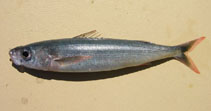Emmelichthys nitidus Richardson, 1845
Cape bonnetmouth
Carregue seu(sua) Fotos e vídeos
Pictures | Imagem do GoogleEmmelichthys nitidus
Picture by Smith, B.
Pictures | Imagem do GoogleEmmelichthys nitidus
Picture by Smith, B.
Common names from other countries
Classificação / Names Nomes comuns | Sinônimos | Catalog of Fishes(Gênero, Espécies) | ITIS | CoL | WoRMS | Cloffa
> Eupercaria/misc (Various families in series Eupercaria) > Emmelichthyidae (Rovers)
Etymology: Emmelichthys: Greek, emmelyes, -es, -es = harmonious + Greek, ichthys = fish + Greek,ops = appearance (Ref. 45335).
More on author: Richardson.
Etymology: Emmelichthys: Greek, emmelyes, -es, -es = harmonious + Greek, ichthys = fish + Greek,ops = appearance (Ref. 45335).
More on author: Richardson.
Environment: milieu / climate zone / depth range / distribution range Ecologia
marinhas batidemersal; intervalo de profundidade 86 - 500 m (Ref. 58489). Deep-water; 16°S - 43°S, 13°W - 167°W
Distribuição Países | Áreas da FAO | Ecossistemas | Ocorrências | Point map | Introduções | Faunafri
Southastern Atlantic: Off western Cape coast in South Africa, Namibia and Tristan da Cunha. Indo-Pacific: Australia, New Zealand, St. Paul and Amsterdam islands. Emmelichthys nitidus cyanescens is found in the eastern Pacific.
Comprimento de primeira maturação / Tamanho / Peso / Idade
Descrição suscinta Chaves de identificação | Morfologia | Morfometria
Espinhos dorsais (total) : 13; Raios dorsais (total) : 9 - 11; Espinhos anais: 3; Raios anais : 10. Reddish, darker (bluish grey) dorsally, silvery white below (Ref. 5325).
A schooling species (Ref. 9563). Reported from between depths of 86 m (Ref. 58489) and 500 m (Ref. 5325). Juveniles occur near the surface, often with schools of clupeids while adults are found near the bottom in deeper water (Ref. 3394). Adults feed mainly on larger zooplankton (Ref. 3394). An excellent food fish; marketed fresh or frozen (Ref. 3394).
Ciclo de vida ou comportamento de acasalamento Maturidade | Reprodução | Desova | Ovos | Fecundidade | Larvas
Asynchronous batch spawner with indeterminate fecundity (Ref. 115109). Spawns once every 3-5 days (Ref. 115109).
Referência principal
Upload your references | Referências | Coordenador : Heemstra, Phillip C. | Colaboradores
Heemstra, P.C., 1984. Emmelichthyidae. In W. Fischer and G. Bianchi (eds.) FAO species identification sheets for fishery purposes. Western Indian Ocean fishing area 51. Vol. 2. (Ref. 3394)
Status na Lista Vermelha da UICN (Ref. 130435: Version 2024-2)
Segura ou pouco preocupante (LC) ; Date assessed: 14 July 2014
Ameaça para os humanos
Harmless
Uso pelos humanos
Pescarias: espécies comerciais
FAO(pescarias: produção; publication : search) | FIRMS (Stock assessments) | FishSource | Sea Around Us
Mais informação
Population dynamics
Parâmetros de crescimento
Max. ages / sizes
Length-weight rel.
Length-length rel.
Frequências de comprimento
Conversão de massa
Recrutamento
Abundância
Parâmetros de crescimento
Max. ages / sizes
Length-weight rel.
Length-length rel.
Frequências de comprimento
Conversão de massa
Recrutamento
Abundância
Life cycle
Reprodução
Maturidade
Fecundidade
Desova
Spawning aggregations
Ovos
Desenvolvimento dos ovos
Larvas
Dinâmica larval
Reprodução
Maturidade
Fecundidade
Desova
Spawning aggregations
Ovos
Desenvolvimento dos ovos
Larvas
Dinâmica larval
Anatomy
Área branquial
Brain
Otolith
Área branquial
Brain
Otolith
Physiology
Body composition
Nutrients
Consumo de oxigênio
Tipo de natação
Velocidade de natação
Visual pigments
Fish sound
Diseases & Parasites
Toxicity (LC50s)
Body composition
Nutrients
Consumo de oxigênio
Tipo de natação
Velocidade de natação
Visual pigments
Fish sound
Diseases & Parasites
Toxicity (LC50s)
Genetics
Genética
Heterozygosity
Hereditariedade
Genética
Heterozygosity
Hereditariedade
Human related
Aquaculture systems
Perfis para aquacultura
Estirpes
Ciguatera cases
Stamps, coins, misc.
Aquaculture systems
Perfis para aquacultura
Estirpes
Ciguatera cases
Stamps, coins, misc.
Ferramentas
Livro eletrônico | Guia de campo | Ferramenta auxiliar de frequências de comprimento | Ferramenta sobre a história de vida | Mapa de pontos | Classification Tree
| Catch-MSY |
Relatórios especiais
Checar Manutenção em Aquário | Checar Planilhas de Fatos sobre as Espécies | Checar Planilhas de Fatos sobre Aquicultura
Baixar XML
Fontes da internet
Aquatic Commons | BHL | Cloffa | BOLDSystems | Websites from users | Checar Observador de Peixes (FishWatcher) | CISTI | Catalog of Fishes(Gênero, Espécies) | DiscoverLife | ECOTOX | Faunafri | Fishtrace | GenBank(genoma, nucleotídeo) | GloBI | GOBASE | | Google Books | Google Scholar | Google | IGFA World Record | MitoFish | Otolith Atlas of Taiwan Fishes | PubMed | Reef Life Survey | Scirus | SeaLifeBase | Árvore da vida | Wikipedia(Ir para, procura) | World Records Freshwater Fishing | Zoobank | Registro zoológico
Estimates based on models
Preferred temperature (Ref. 115969): 9.6 - 16.6, mean 13.1 (based on 101 cells).
Índice de diversidade filogenética (Ref. 82804): PD50 = 0.5156 [Uniqueness, from 0.5 = low to 2.0 = high].
Bayesian length-weight: a=0.00389 (0.00180 - 0.00842), b=3.12 (2.94 - 3.30), in cm Total Length, based on all LWR estimates for this body shape (Ref. 93245).
Nível Trófico (Ref. 69278): 3.4 ±0.41 se; based on food items.
Resiliência (Ref. 120179): médio(a), tempo mínimo de duplicação da população 1,4 - 4,4 anos (tm=2.5; Tmax=8-21; batch Fecundity>1000).
Fishing Vulnerability (Ref. 59153): Moderate vulnerability (42 of 100).
Climate Vulnerability (Ref. 125649): Low vulnerability (7 of 100).




